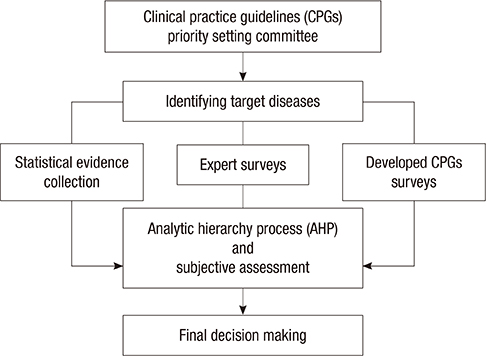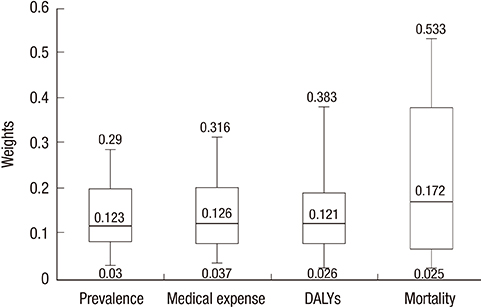J Korean Med Sci.
2015 Dec;30(12):1733-1742. 10.3346/jkms.2015.30.12.1733.
National Priority Setting of Clinical Practice Guidelines Development for Chronic Disease Management
- Affiliations
-
- 1Department of Health Management and Policy, Kangwon National University School of Medicine, Chuncheon, Korea.
- 2The Executive Committee for Clinical Practice Guidelines, The Korean Academy of Medical Sciences, Seoul, Korea.
- 3Department of Radiology, Yonsei University Sevrance Hospital, Yonsei University College of Medicine, Seoul, Korea.
- 4Department of Preventive Medicine, Kangwon National University Hospital, Chuncheon, Korea. somanghana@gmail.com
- KMID: 2359956
- DOI: http://doi.org/10.3346/jkms.2015.30.12.1733
Abstract
- By November 2013, a total of 125 clinical practice guidelines (CPGs) have been developed in Korea. However, despite the high burden of diseases and the clinical importance of CPGs, most chronic diseases do not have available CPGs. Merely 83 CPGs are related to chronic diseases, and only 40 guidelines had been developed in the last 5 yr. Considering the rate of the production of new evidence in medicine and the worsening burden from chronic diseases, the need for developing CPGs for more chronic diseases is becoming increasingly pressing. Since 2011, the Korean Academy of Medical Sciences and the Korea Centers for Disease Control and Prevention have been jointly developing CPGs for chronic diseases. However, priorities have to be set and resources need to be allocated within the constraint of a limited funding. This study identifies the chronic diseases that should be prioritized for the development of CPGs in Korea. Through an objective assessment by using the analytic hierarchy process and a subjective assessment with a survey of expert opinion, high priorities were placed on ischemic heart disease, cerebrovascular diseases, Alzheimer's disease and other dementias, osteoarthritis, neck pain, chronic kidney disease, and cirrhosis of the liver.
MeSH Terms
Figure
Reference
-
1. Yoon SJ, Bae SC, Lee SI, Chang H, Jo HS, Sung JH, Park JH, Lee JY, Shin Y. Measuring the burden of disease in Korea. J Korean Med Sci. 2007; 22:518–523.2. Khang YH. Burden of noncommunicable diseases and national strategies to control them in Korea. J Prev Med Public Health. 2013; 46:155–164.3. Lozano R, Naghavi M, Foreman K, Lim S, Shibuya K, Aboyans V, Abraham J, Adair T, Aggarwal R, Ahn SY, et al. Global and regional mortality from 235 causes of death for 20 age groups in 1990 and 2010: a systematic analysis for the Global Burden of Disease Study 2010. Lancet. 2012; 380:2095–2128.4. OECD Health Division. OECD Heath Care Quality Review. Korea, Assessment and Recommendation. Paris, France: OECD;2012. p. 12.5. Lee JH, Choi YJ, Lee SH, Sung NJ, Kim SY, Hong JY. Association of the length of doctor-patient relationship with primary care quality in seven family practices in Korea. J Korean Med Sci. 2013; 28:508–515.6. Health Insurance Review and Assessment Service. Diabete healthcare quality assessment report. Seoul, Korea: Health Insurance Review and Assessment Service;2014.7. Lee JY, Jo MW, Yoo WS, Kim HJ, Eun SJ. Evidence of a broken healthcare delivery system in Korea: unnecessary hospital outpatient utilization among patients with a single chronic disease without complications. J Korean Med Sci. 2014; 29:1590–1596.8. Kwon S. Payment system reform for health care providers in Korea. Health Policy Plan. 2003; 18:84–92.9. Ock M, Kim JE, Jo MW, Lee HJ, Kim HJ, Lee JY. Perceptions of primary care in Korea: a comparison of patient and physician focus group discussions. BMC Fam Pract. 2014; 15:178.10. Oh MK, Jo H, Lee YK. Improving the reliability of clinical practice guideline appraisals: effects of the Korean AGREE II scoring guide. J Korean Med Sci. 2014; 29:771–775.11. Lee YK, Shin ES, Shim JY, Min KJ, Kim JM, Lee SH. Executive Committee for CPGs. Korean Academy of Medical Sciences. Developing a scoring guide for the Appraisal of Guidelines for Research and Evaluation II instrument in Korea: a modified Delphi consensus process. J Korean Med Sci. 2013; 28:190–194.12. Reddy BP, Kelly MP, Thokala P, Walters SJ, Duenas A. Prioritising public health guidance topics in the National Institute for Health and Care Excellence using the Analytic Hierarchy Process. Public Health. 2014; 128:896–903.13. Mitton C, Donaldson C. Health care priority setting: principles, practice and challenges. Cost Eff Resour Alloc. 2004; 2:3.14. Légaré F, Ratté S, Gravel K, Graham ID. Barriers and facilitators to implementing shared decision-making in clinical practice: update of a systematic review of health professionals' perceptions. Patient Educ Couns. 2008; 73:526–535.15. Geneau R, Stuckler D, Stachenko S, McKee M, Ebrahim S, Basu S, Chockalingham A, Mwatsama M, Jamal R, Alwan A, et al. Raising the priority of preventing chronic diseases: a political process. Lancet. 2010; 376:1689–1698.16. Sabik LM, Lie RK. Priority setting in health care: Lessons from the experiences of eight countries. Int J Equity Health. 2008; 7:4.17. Oh J, Ko Y, Alley AB, Kwon S. Participation of the lay public in decision-making for benefit coverage of national health insurance in South Korea. Health Syst Reform. 2015; 1:62–71.18. Murray CJ, Ezzati M, Flaxman AD, Lim S, Lozano R, Michaud C, Naghavi M, Salomon JA, Shibuya K, Vos T, et al. GBD 2010: design, definitions, and metrics. Lancet. 2012; 380:2063–2066.19. Iglehart JK. Prioritizing comparative-effectiveness research--IOM recommendations. N Engl J Med. 2009; 361:325–328.20. Saaty TL. Decision making with the analytic hierarchy process. Int J Serv Sci. 2008; 1:83–98.21. Dolan JG, Isselhardt BJ Jr, Cappuccio JD. The analytic hierarchy process in medical decision making: a tutorial. Med Decis Making. 1989; 9:40–50.22. Ahn HS, Kim HJ. Development and implementation of clinical practice guidelines: current status in Korea. J Korean Med Sci. 2012; 27:S55–S60.23. Shin YS, Kim YI, editors. Health policy and management. Seoul, Korea: Seoul National University Press;2013.24. Lim D, Ha M, Song I. Trends in the leading causes of death in Korea, 1983-2012. J Korean Med Sci. 2014; 29:1597–1603.25. RAND. London School of Hygiene and Tropical Medicine. Ellen N, Jennifer N, Annalijn C, editors. International variation in the usage of medicines: a review of the literature. California, US: RAND;2010. p. 3–4. p. 15–19.26. Kim YJ, Han JW, So YS, Seo JY, Kim KY, Kim KW. Prevalence and trends of dementia in Korea: a systematic review and meta-analysis. J Korean Med Sci. 2014; 29:903–912.27. Ministry of Health and Welfare. Health Plan 2020. Seoul, Korea: Ministry of Health and Welfare;2011. p. 255–275.28. Kang IO, Park CY, Lee Y. Role of healthcare in Korean long-term care insurance. J Korean Med Sci. 2012; 27:S41–S46.29. Legido-Quigley H, Panteli D, Brusamento S, Knai C, Saliba V, Turk E, Solé M, Augustin U, Car J, McKee M, et al. Clinical guidelines in the European Union: mapping the regulatory basis, development, quality control, implementation and evaluation across member states. Health Policy. 2012; 107:146–156.30. Bussières A, Stuber K. The Clinical Practice Guideline Initiative: a joint collaboration designed to improve the quality of care delivered by doctors of chiropractic. J Can Chiropr Assoc. 2013; 57:279–284.31. Lo B, Field MJ. Institute of Medicine of the National Academies (US), Committee on Conflict of Interest in Medical Research, Education, and Practice. Conflict of interest in medical research, education, and practice. Washington, DC: National Academy Press;2009. p. 191.32. Korea Institute for Health and Social Affairs. Kim NS, Kim SY, Park EJ. Promoting the Quality of Medicine: Based on Clinical Practice Guidelines. . Seoul, Korea: Korea Institue for Health and Social Affairs;2004. p. 28–30.
- Full Text Links
- Actions
-
Cited
- CITED
-
- Close
- Share
- Similar articles
-
- KASL clinical practice guidelines for management of chronic hepatitis B
- 2018 Korean Association for the Study of the Liver (KASL) Clinical Practice Guidelines of Chronic Hepatitis B: What's Different?
- KASL clinical practice guidelines for management of chronic hepatitis B
- Priorities of Nursing Research Areas in Korea
- Development and Implementation of Clinical Practice Guidelines: Current Status in Korea




